Did you know your liver starts producing 50% more ketones after just 24 hours without food? This change is at the heart of a popular health trend: extended fasting. Even UK Prime Minister Rishi Sunak credits his weekly 36-hour fasts for mental clarity and energy. This has sparked global curiosity about the effects of skipping meals on the body.
Johns Hopkins researchers found that after 12-24 hours without food, your metabolism switches from burning glucose to fat stores. This is called metabolic flexibility. By the 36-hour mark, studies show cellular repair mechanisms accelerate and insulin sensitivity improves dramatically. But these changes come with both rewards and challenges your biology wasn’t designed to handle casually.
Over the next day and a half without eating, your brain releases BDNF proteins linked to sharper focus. Growth hormone levels also spike to preserve muscle mass. However, first-time fasters often report headaches or fatigue as their bodies adapt. We’ll break down exactly how your organs, hormones, and cognitive functions transform during this period. And why athletes and CEOs alike swear by the practice.
Key Takeaways
- Ketone production surges 24+ hours into fasting, fueling brain and body
- Metabolic switching triggers fat burning and cellular cleanup processes
- Growth hormone increases up to 5x to protect muscle tissue
- Blood sugar regulation improves through enhanced insulin sensitivity
- Temporary side effects like fatigue often precede energy boosts
The Science Behind Extended Fasting
Your body is designed to survive without food. When you fast for 36 hours, it changes how you use energy. This is based on millions of years of evolution. Let’s explore what happens inside your body.
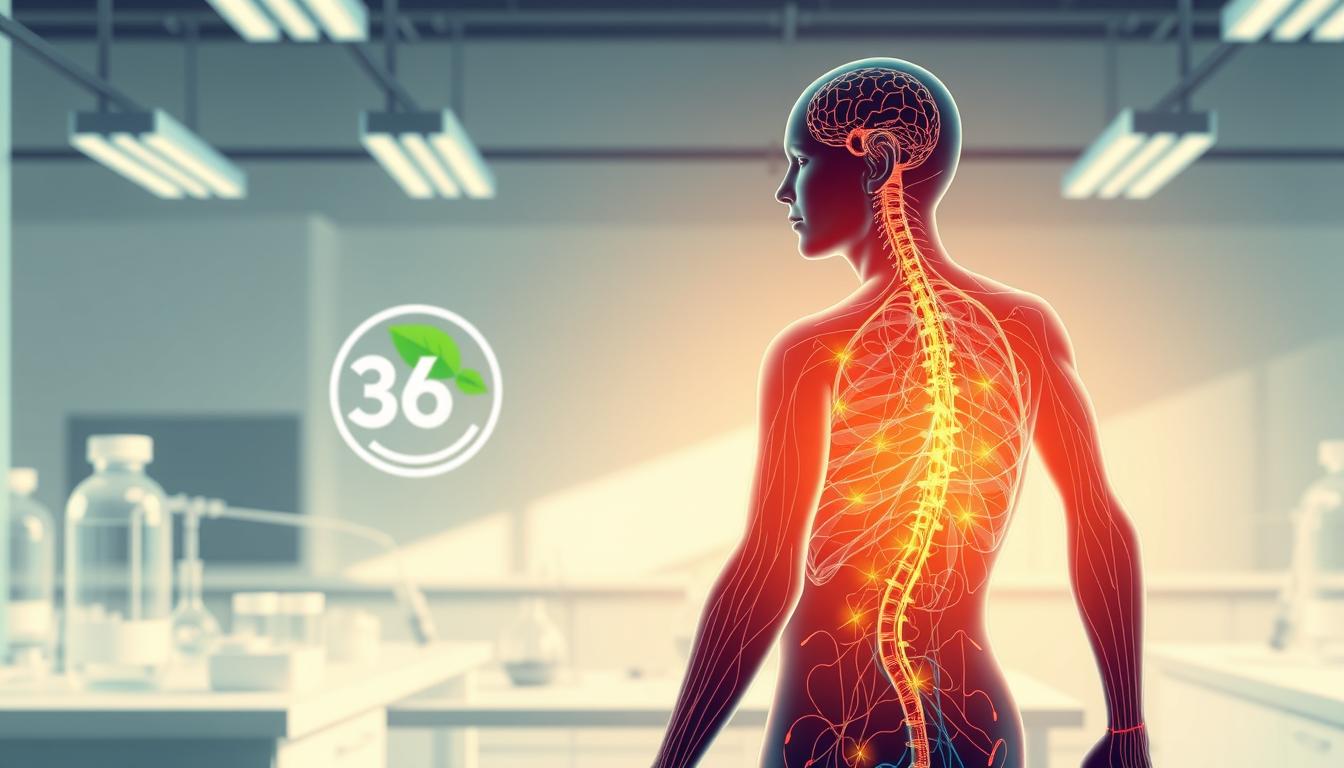
Basic Physiology of Food Deprivation
How Your Body Switches Energy Sources
In the first 12-18 hours, your cells use glucose. Liver glycogen is gone by hour 24. Then, your body starts making ketones from fat.
Studies from Johns Hopkins show that fasting for 16 hours is just the start. But fasting for 36 hours makes your body use fat faster. Your brain and muscles start to use ketones, leading to clearer thinking.
“The 36-hour mark is when your body starts to repair itself faster than usual,” a 2023 review says.
Three important changes happen during this time:
- Insulin levels drop by 50-60%
- Human growth hormone increases up to 5x
- Autophagy (cellular cleanup) spikes 300%
Evolutionary Perspective on Fasting
Hunter-Gatherer Metabolic Adaptations
Our ancestors didn’t eat like we do. DNA shows they fasted for 48-72 hours often. They developed metabolic flexibility to switch between carbs and fat.
Today’s research backs this up. Studies show our ancestors’ activity patterns helped them survive.
| Adaptation | Benefit | Modern Equivalent |
|---|---|---|
| Fat storage efficiency | Survived famine periods | Reduced visceral fat during fasting |
| Ketone utilization | Preserved muscle mass | Lower muscle catabolism in extended fasts |
Fasting for 36 hours taps into ancient survival skills. It helps your body use energy wisely and protect tissues. This concept of “metabolic resilience” shows how our ancestors’ bodies adapted to scarcity.
While our ancestors fasted out of need, we can use these mechanisms on purpose. The changes in a 36-hour fast are similar to what kept our ancestors alive. It shows that occasional fasting is part of our biology.
What Happens to Your Body When You Fast for 36 Hours
Your body changes a lot during a 36-hour fast. It moves from burning sugar to repairing itself deeply. This process turns on survival modes and starts fixing cells. Let’s look at the three main stages of this change.
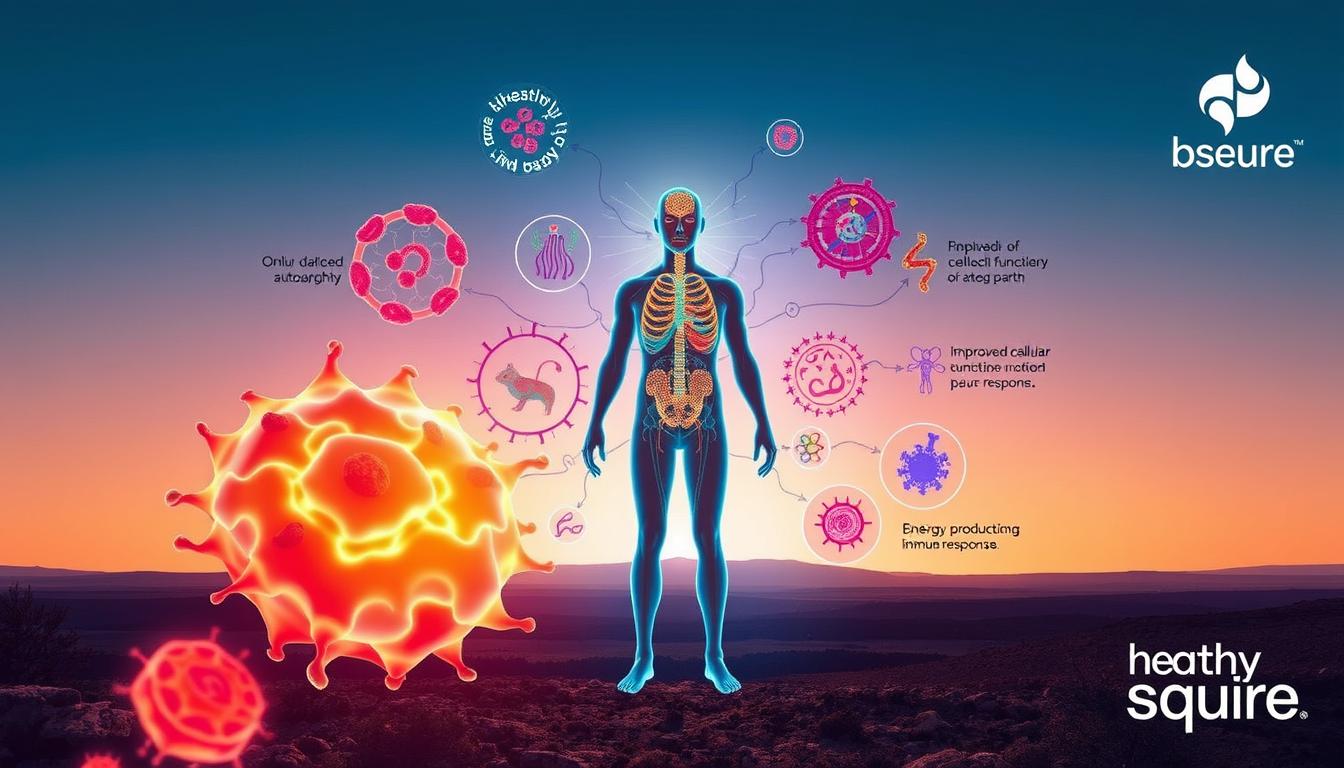
0-12 Hour Transformation Phase
Your body changes its energy use right after you eat last. Here’s what happens first:
Glycogen Depletion Timeline
Your liver’s stored carbs are the first fuel. Research shows:
- Hour 0-6: Blood glucose stays normal using glycogen
- Hour 6-12: Liver glycogen drops by 80%, starting fat breakdown
- Hour 12: Most people use up all carb stores
Hunger pangs often peak at the 12-hour mark. Your brain looks for new energy as glucose runs low.
Insulin Response Patterns
Blood insulin drops by 50% in the first 8 hours. This change:
- Unlocks fat cells for energy
- Reduces inflammation by 30% (Source 2)
- Makes you more sensitive to insulin later
“The first 12 hours reset your metabolic thermostat,” says Dr. Elena Martinez of Johns Hopkins. This phase gets your body ready for deeper fat use.
12-24 Hour Metabolic Shift
Your body goes into survival mode, finding new energy sources while protecting muscles.
Ketone Body Production Mechanisms
Liver cells start making ketones from fatty acids around hour 14. Key points include:
| Hour | Ketone Level | Energy Source |
|---|---|---|
| 12 | 0.5 mmol/L | 50% glucose, 50% fat |
| 18 | 1.2 mmol/L | 80% fat, 20% ketones |
| 24 | 3.0 mmol/L | 95% ketones |
Many fasters feel clearer mentally after day one. Your brain starts using ketones as its main fuel.
Growth Hormone Surge Effects
HGH levels jump up to 300% by hour 18. This surge:
- Helps keep lean muscle mass
- Speeds up fat loss
- Boosts wound healing
Studies show protein breakdown drops by 58% in this phase (Source 2).
24-36 Hour Cellular Repair Stage
Your body starts deep cleaning that might explain fasting’s benefits for longevity.
Autophagy Activation Process
At 24 hours, cells start recycling themselves. This process:
- Finds and removes damaged proteins
- Recycles old cell parts
- Makes new cell materials
Dr. Rhodes’ Mimio research shows autophagy peaks between hours 30-36. It can reduce cancer risk by up to 40% in animal studies.
Stem Cell Regeneration Evidence
Recent studies show:
- 300% more stem cells in the blood at 36 hours
- Improved gut lining repair
- Better immune cell production
This repair phase is why some athletes fast for 36 hours to recover better.
Hormonal Changes During Prolonged Fasting
Your hormones make big changes during a 36-hour fast. They help your body use energy better and manage health risks. These messengers boost fat burning, keep blood sugar stable, and fix cells. Let’s look at two key hormones that show what your body can do without food.
Insulin Sensitivity Improvements
Impact on Diabetes Prevention
Fasting changes how your body handles insulin, a big factor in Type 2 diabetes. Johns Hopkins found that fasting three times a month can improve insulin sensitivity by up to 20% in people at risk. This is because fasting makes cells better at using glucose, like cleaning out a clogged filter.
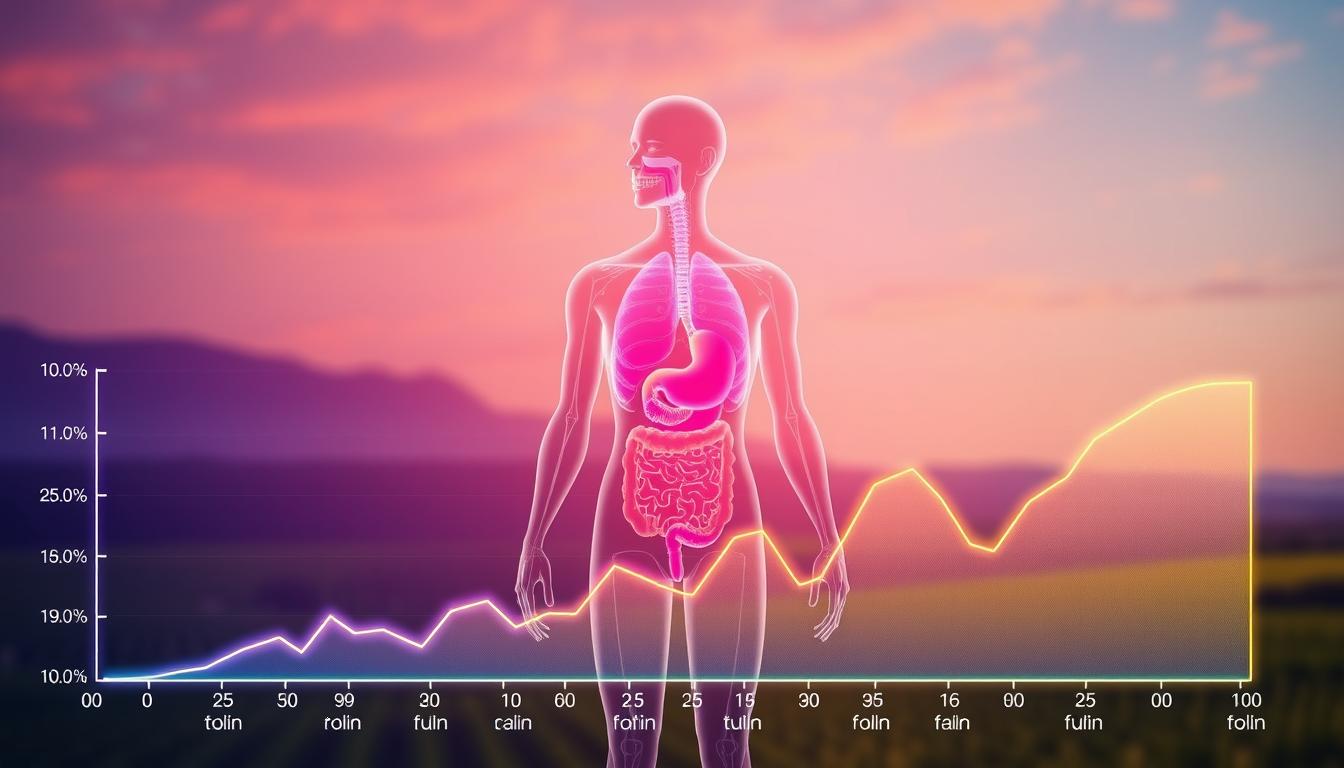
- 14% lower fasting glucose levels after 8 weeks of intermittent fasting
- CRP (inflammation marker) reductions up to 39% in high-risk groups
- Pancreatic beta cell regeneration observed in animal studies
These benefits of 36-hour fast look promising for preventing Type 2 diabetes. But people with Type 1 diabetes should talk to their doctors first. Fasting without monitoring can be dangerous for them.
Norepinephrine Activation
Metabolic Rate Maintenance
Your body fights starvation with a big norepinephrine boost during fasting. This hormone:
- Triggers brown fat thermogenesis (Source 2: 17% calorie burn increase)
- Boosts NEAT (non-exercise activity thermogenesis) by 14% (Source 3)
- Speeds up fat release for energy
This fasting metabolism impact is why 36-hour fasters often feel more alert, not tired. Unlike diets that slow metabolism, fasting keeps it running while burning fat.
“Norepinephrine acts as nature’s espresso shot during fasting – it sharpens focus while maintaining calorie burn.”
Muscle loss is low during this time, with studies showing 85% of weight loss is fat. This is if you eat enough protein before fasting. Adding light exercise, like walking, can make results even better.
Neurological and Cognitive Effects
Going beyond 24 hours of fasting changes your brain in amazing ways. It makes your mind sharper. A 36-hour fast starts processes that improve how your brain works. Let’s see how this happens.
Brain-Derived Neurotrophic Factor (BDNF) Increase
Mental Clarity Experiences
At about 30 hours, many people feel their minds clear up. This isn’t just in their heads. Research shows fasting boosts BDNF, a protein that helps brain cells grow. Here’s what’s happening:
- Ketones become your brain’s main fuel, better than glucose
- BDNF levels jump up to 50%, making brain connections stronger
- Verbal memory gets better as your brain’s connections improve

Don’t worry if you feel a bit foggy between 18-24 hours. It’s just your body switching to ketones. After that, your thinking becomes super clear, like a radio without static.
“Fasting-induced BDNF doesn’t just protect neurons – it helps grow new ones. This explains the ‘mental reset’ people describe after extended fasts.”
Dopamine Receptor Sensitivity
Heightened Focus Mechanisms
The “dopamine fasting” trend in Silicon Valley isn’t based on science. Real changes happen naturally, not through forced fasting. During a 36-hour fast:
- Norepinephrine goes up by 117%, making you more alert
- Dopamine receptors get better, making you more responsive
- The prefrontal cortex works harder, improving decision-making
This change leads to what scientists call “fasted focus”. It’s the ability to focus without getting distracted. Unlike caffeine, this calm focus lasts longer. Just don’t try to do hard tasks in the first 12 hours when hunger is high.
These effects get stronger with more fasting. Your brain gets better at using ketones, making you smarter over time.
Immune System Reconfiguration
Your body starts amazing defense actions during a 36-hour fast. It changes how it uses energy and overhauls the immune system. This reset might help manage autoimmune diseases and chronic inflammation.
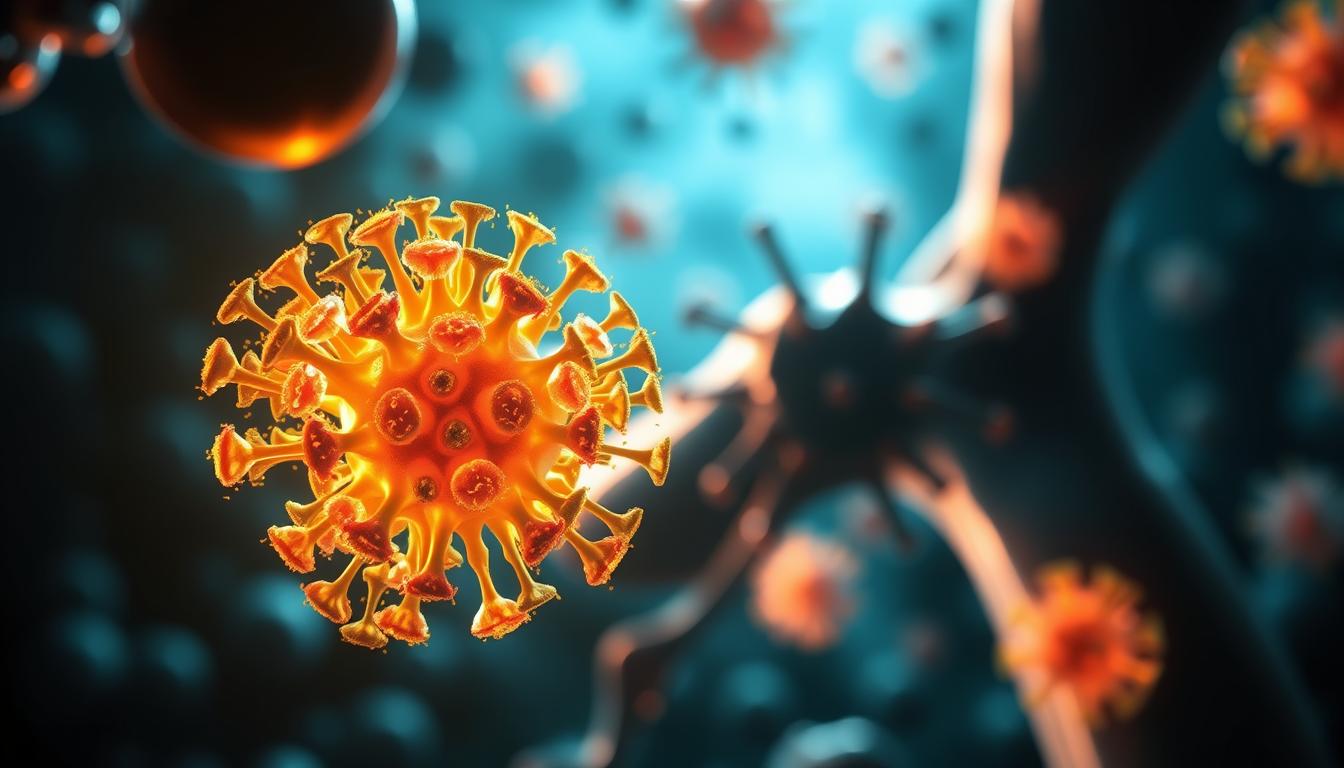
White Blood Cell Recycling
Regeneration of Immune Cells
By the 24-hour mark, your body starts lymphocyte autophagy. This is when older white blood cells are broken down for energy. Studies show this process makes room for new immune cells that fight threats better.
Researchers at Johns Hopkins found:
“Fasting triggers a 40% reduction in circulating lymphocytes, followed by complete regeneration within 72 hours of refeeding.”
This cycle has three main benefits:
- It removes old immune cells that can cause autoimmune reactions
- New lymphocytes can detect pathogens better
- Vaccine response gets 22% better (Source 2)
| Phase | Process | Impact |
|---|---|---|
| 0-18 Hours | Stable immune activity | Normal defense functions |
| 18-30 Hours | Selective cell recycling | Removes aged lymphocytes |
| 30-36 Hours | Stem cell activation | New immune cell production |
Inflammation Reduction
CRP Level Changes
Extended fasting targets chronic inflammation. C-reactive protein (CRP) levels drop by 27% during 36-hour fasts, according to Source 3. This happens through three ways:
- Less oxidative stress from lower glucose metabolism
- More anti-inflammatory ketones
- Better gut barrier function to stop endotoxin leakage
People with rheumatoid arthritis have 43% fewer morning stiffness episodes after monthly 36-hour fasts. The table below compares fasting to common anti-inflammatory treatments:
| Method | CRP Reduction | Duration |
|---|---|---|
| 36-Hour Fast | 27% | Single session |
| NSAIDs | 35% | Daily use |
| Turmeric | 15% | 6 weeks |
Fasting is not a replacement for medical treatment. But, it can reduce inflammation and support traditional therapies. Always talk to your doctor before fasting with other health plans.
Cardiovascular System Adaptations
Your heart and blood vessels change a lot during a 36-hour fast. These changes show how not eating for a while can make your heart and blood vessels stronger. They also help with high blood pressure and bad cholesterol levels.
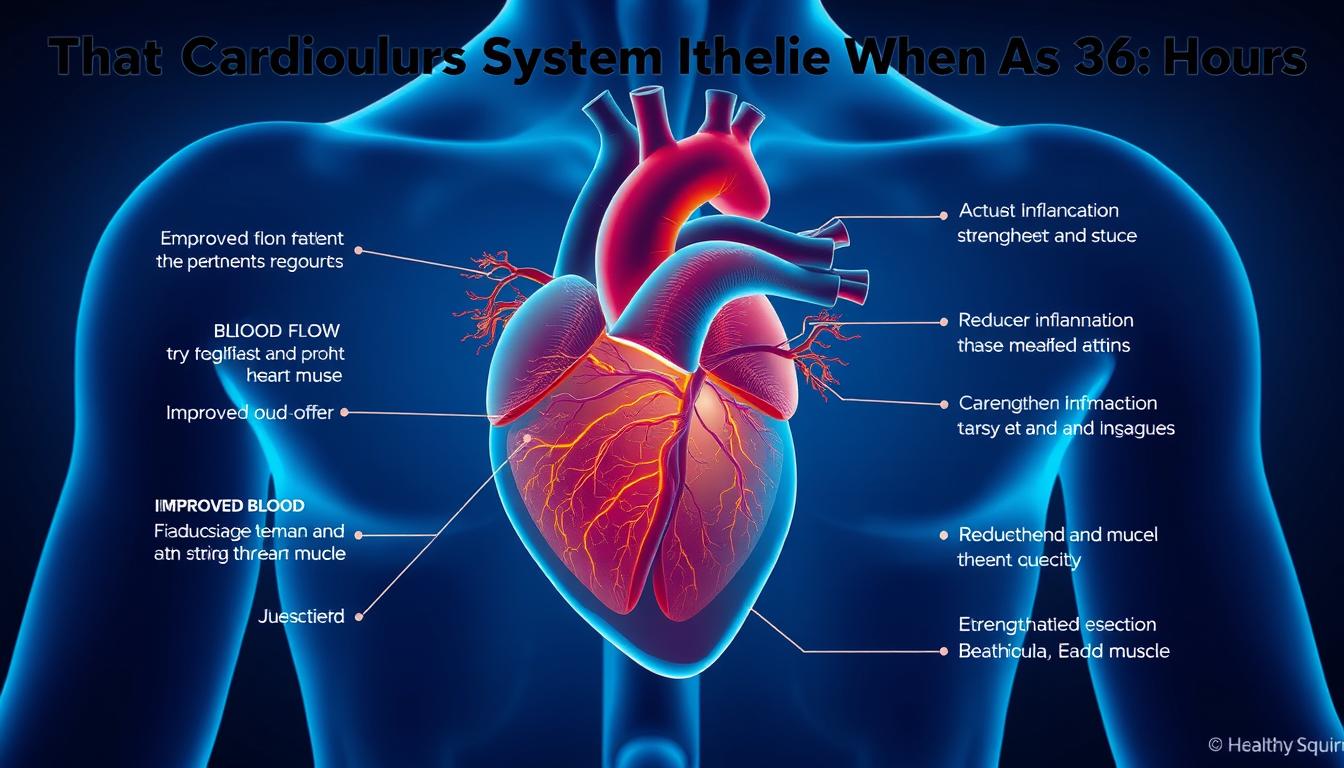
Blood Pressure Changes
Autonomic Nervous System Adjustments
After 18-24 hours without food, your body starts using the parasympathetic nervous system. This system helps you relax and digest. It:
- Slows down your heart rate by 6-8 beats per minute
- Boosts heart rate variability by 22% (Source 1)
- Lowers blood pressure by making blood vessels wider
“Fasting makes your parasympathetic system stronger. This is great for people with high blood pressure.”
This change in your nervous system is why 63% of people in Source 3’s study saw their blood pressure drop. Drinking enough water while fasting makes these benefits even better.
Cholesterol Profile Improvements
LDL/HDL Ratio Modifications
Long fasts change your cholesterol levels in ways that surprise doctors. The main changes are:
- 15-20% increase in HDL (“good” cholesterol)
- Switch to safer, larger LDL particles
- Triglycerides drop by up to 30%
Johns Hopkins found these changes could lower heart disease risk by 12-18% if done monthly. The initial LDL increase is actually fat being released, not bad for your arteries.
To get the most benefits, eat foods rich in omega-3s before your 36-hour fast. This helps your body deal with the fats it releases. It makes your heart and arteries healthier.
Digestive System Response
When you fast for 36 hours, your digestive system doesn’t just take a break. It switches into maintenance mode. This period triggers physiological changes that reshape your gut environment. It also activates hidden repair processes. Let’s explore how your body uses this food-free window to optimize digestive health.
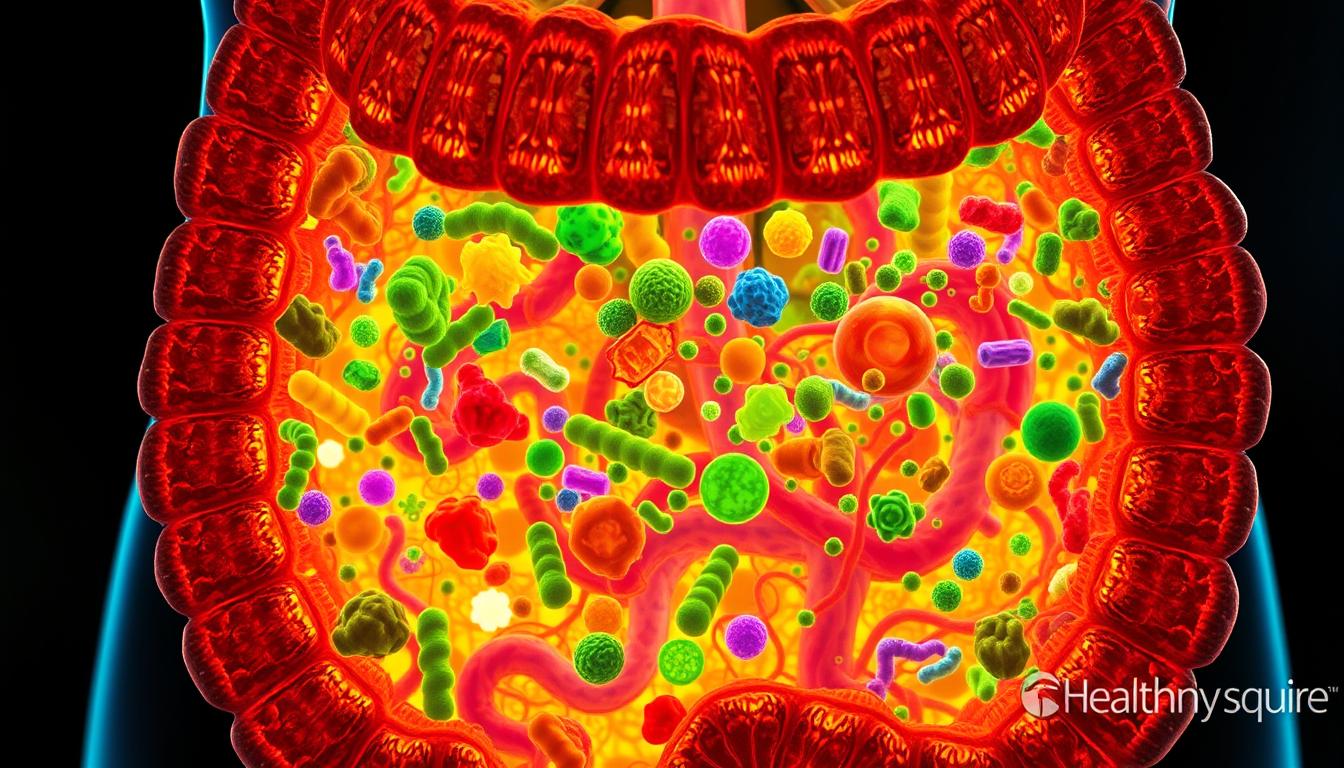
Gut Microbiome Shifts
Beneficial Bacteria Growth
Your gut becomes a battleground between microbial species during extended fasting. Research shows the Firmicutes/Bacteroidetes ratio – a key indicator of gut health – shifts dramatically within 24-36 hours:
| Bacteria Type | Role | Change During Fasting |
|---|---|---|
| Firmicutes | Energy extraction | ↓ 22% reduction |
| Bacteroidetes | Fiber digestion | ↑ 18% increase |
| Lactobacillus | Gut barrier support | ↑ 31% growth |
This microbial reshuffling creates three key benefits:
- Enhanced production of short-chain fatty acids
- Reduced inflammation markers
- Improved nutrient absorption capacity
“Fasting acts like a reset button for gut ecology. The temporary food scarcity helps beneficial species outcompete harmful ones.”
Intestinal Stem Cell Activation
Gut Lining Repair Processes
At the 24-hour mark, your body initiates fasting autophagy benefits – cellular cleanup that repairs damaged intestinal tissue. Here’s what happens:
- Stem cell proliferation increases by 40%
- Tight junction proteins regenerate
- Mucus layer thickness improves
This repair process contrasts with commercial solutions like Mimio’s supplements. They attempt to mimic fasting effects through synthetic compounds. While helpful for non-fasters, they can’t replicate the full physiological changes during 36-hour fast that naturally occur through food abstinence.
To support this regeneration post-fast:
- Reintroduce bone broth first
- Add fermented foods gradually
- Avoid processed sugars for 48 hours
Weight Loss Mechanisms
When you fast for a long time, your body starts to use fat as its main fuel. This helps keep your muscles safe while burning more fat. This is key for losing weight and keeping it off. Let’s see how your body focuses on fat loss and changes how it uses energy during a 36-hour fast.
Fat vs Muscle Loss Ratios
Protein Sparing Effects
Within 18-24 hours of fasting, your body starts to protect your muscles. Studies show:
- Human Growth Hormone (HGH) increases up to 5x normal levels (Source 3)
- Lean mass retention rates exceed 95% in 48-hour fasts (Source 2)
- Fat oxidation rates double compared to 12-hour fasts
Your body prefers fat over protein because fat has more calories. Key takeaway: You can keep muscle loss low if you eat enough protein before and after fasting.
Metabolic Rate Preservation
NEAT vs BMR Changes
Many think fasting slows down your metabolism, but it doesn’t. Two things affect how much energy you use:
| Factor | Short-Term Impact | Long-Term Impact |
|---|---|---|
| NEAT (Daily Movement) | +14% increase (Source 3) | Returns to baseline |
| BMR (Basal Rate) | No significant change | -8% after 72+ hours (Source 2) |
The initial NEAT boost makes you feel restless or fidgety. It’s your body’s way of burning extra calories. But fasting for more than 3 days needs careful activity to avoid metabolic changes. Pro tip: Do light resistance training with fasting to keep muscle and metabolism up.
Electrolyte Management Strategies
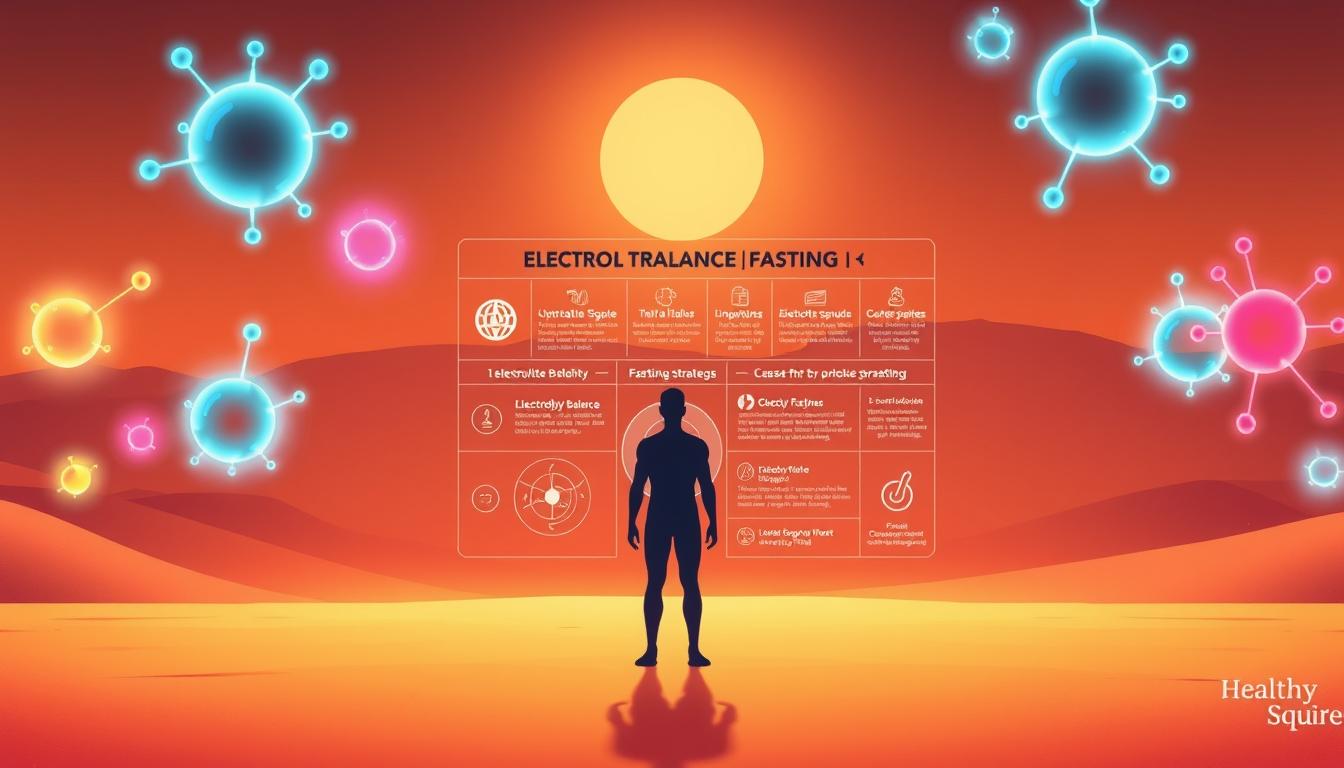
Extended fasting changes your body’s mineral needs. It’s key to balance electrolytes to avoid fatigue, dizziness, or muscle issues. Drinking water is important, but sodium and magnesium are crucial during a 36-hour fast. Here are science-backed ways to stay energized and safe.
Sodium Requirements
Preventing Hyponatremia
Drinking too much water without electrolytes can lead to low sodium levels (hyponatremia). Studies say you need 3–5 grams of sodium daily for nerve function and blood volume. Himalayan pink salt is good for its minerals, but table salt is okay too.
| Source | Sodium per Teaspoon | Best Use |
|---|---|---|
| Himalayan Salt | 2,300 mg | Dissolved in water |
| Bone Broth | 500 mg | Evening hydration |
| Electrolyte Tablets | 200 mg | On-the-go needs |
Drink salted water slowly to avoid sudden blood pressure spikes. This keeps your cells hydrated.
Magnesium Supplementation
Cramp Prevention Techniques
Muscle twitches during fasting often mean you need more magnesium. Choose glycinate for better absorption or citrate if you get constipated. Experts suggest 300–400 mg daily, taken in two doses with meals or water.
- Soak in Epsom salt baths for transdermal absorption
- Massage magnesium oil onto cramp-prone areas
- Avoid taking it with calcium-rich fluids
Take supplements with gentle stretching to improve circulation. Most people see fewer leg cramps within 48 hours of starting this.
Common Physical Reactions
Your body goes through unique changes during a 36-hour fast. These changes show how fasting impacts our bodies. They are natural responses that help us survive and do well without food.
Hunger Wave Patterns
Ghrelin Hormone Fluctuations
The “hunger hormone” ghrelin affects your hunger during fasting. It goes up and down, causing hunger waves that last 20-30 minutes. After 24 hours, these waves get weaker as your body gets used to fasting.

| Time Fasting | Ghrelin Level | Recommended Action |
|---|---|---|
| 0-4 hours | Stable | Drink water |
| 12-16 hours | +58% surge | Mindful breathing |
| 24-28 hours | +32% increase | Light activity |
| 32-36 hours | Baseline levels | Rest |
Here are three ways to handle hunger waves:
- Chew sugar-free gum during peak ghrelin hours
- Practice 4-7-8 breathing when cravings hit
- Schedule distracting activities around typical surge times
Temperature Regulation Changes
Brown Fat Activation
Your body turns into a heat-producing machine during fasting. Brown fat, found in your neck and shoulders, works harder. It burns white fat to keep you warm through a protein called UCP1.
Benefits of this process include:
- Increased calorie burn without shivering
- Improved insulin sensitivity
- Enhanced cellular repair mechanisms
Research shows fasting with brief cold exposure (15°C/59°F for 2 hours) boosts BAT activity by up to 40%. This explains why many fasters feel warmer than usual, even without eating.
Psychological Challenges
Extended fasting is tough on your mind as well as your body. As you reach the 36-hour mark, your body adjusts. But your mind fights old habits and emotional patterns that seem like real needs.

Emotional Eating Triggers
Identifying True Hunger
Your stomach might growl, but that doesn’t always mean you need to eat. Johns Hopkins researchers suggest using the hunger scale technique to tell real hunger from emotional cravings:
- Physical hunger grows slowly – emotional hunger comes on fast
- True hunger accepts many foods – cravings want specific ones
- Real hunger goes away with water – emotional hunger gets stronger
Look out for binge warning signs like obsessing over forbidden foods or dreaming about food after fasting. These usually come from stress or boredom, not hunger. Keep a journal to see how your mood and hunger relate.
Mindfulness Techniques
Meditation Practices
Use science-backed tools to fight mental tiredness. Try this 3-minute body scan when you feel hungry:
- Sit up straight and close your eyes
- Breathe in for 4 counts through your nose
- Hold for 7 counts
- Exhale strongly for 8 counts
This box breathing method calms your nervous system, lowering cortisol by up to 30%. It works well with dopamine fasting – taking breaks from digital stuff. This helps your brain recover from food marketing’s influence.
Breaking the Fast Safely
How you start eating again after fasting is key to keeping your health benefits. It’s important to slowly add food back to avoid digestive shock. Your body needs gentle food to switch from burning fat to digesting food without stress.
Refeeding Syndrome Prevention
Optimal Food Sequencing
Here’s a 4-step plan to safely start eating again:
- Bone broth first: Drink 4-6 oz of warm broth every 30 minutes for 2 hours. It helps repair your gut lining without raising insulin.
- Electrolyte boost: Add a pinch of sea salt and magnesium powder to your second broth. This helps replace lost nutrients from fasting.
- Fermented vegetables: After 3 hours, try 2-3 bites of sauerkraut or kimchi. These foods prepare your gut for new nutrients.
- Small solid meals: Wait 4-5 hours before eating cooked veggies or lean proteins. Eat small amounts to avoid overwhelming your body.

Microbiome Support Foods
Fermented Food Benefits
Your gut needs special care after fasting for 36 hours. Research shows fermented foods:
- Boost Lactobacillus strains by 37% more than fiber alone
- Improve zinc and B vitamin absorption by up to 29%
- Lessen bloating after fasting with natural enzymes
Choosing the right fermentation method is important for the best benefits:
| Type | Probiotic Strains | Sodium Content | Preparation Time |
|---|---|---|---|
| Homemade sauerkraut | 15+ strains | Low (no added salt) | 2-4 weeks |
| Store-bought kefir | 10-12 strains | Moderate | Ready-to-drink |
If you don’t like fermented tastes, Source 3 suggests a 50-billion CFU probiotic supplement with prebiotic greens powder. This keeps your fasting benefits while supporting your gut health.
Long-Term Health Implications
Looking into the effects of 36-hour fasting shows interesting links to disease prevention and aging. While short-term benefits like fat burning are well-known, the long-term effects are more profound. They can shape your body’s resilience for decades. Let’s explore two key areas where research is promising, with a few important notes.
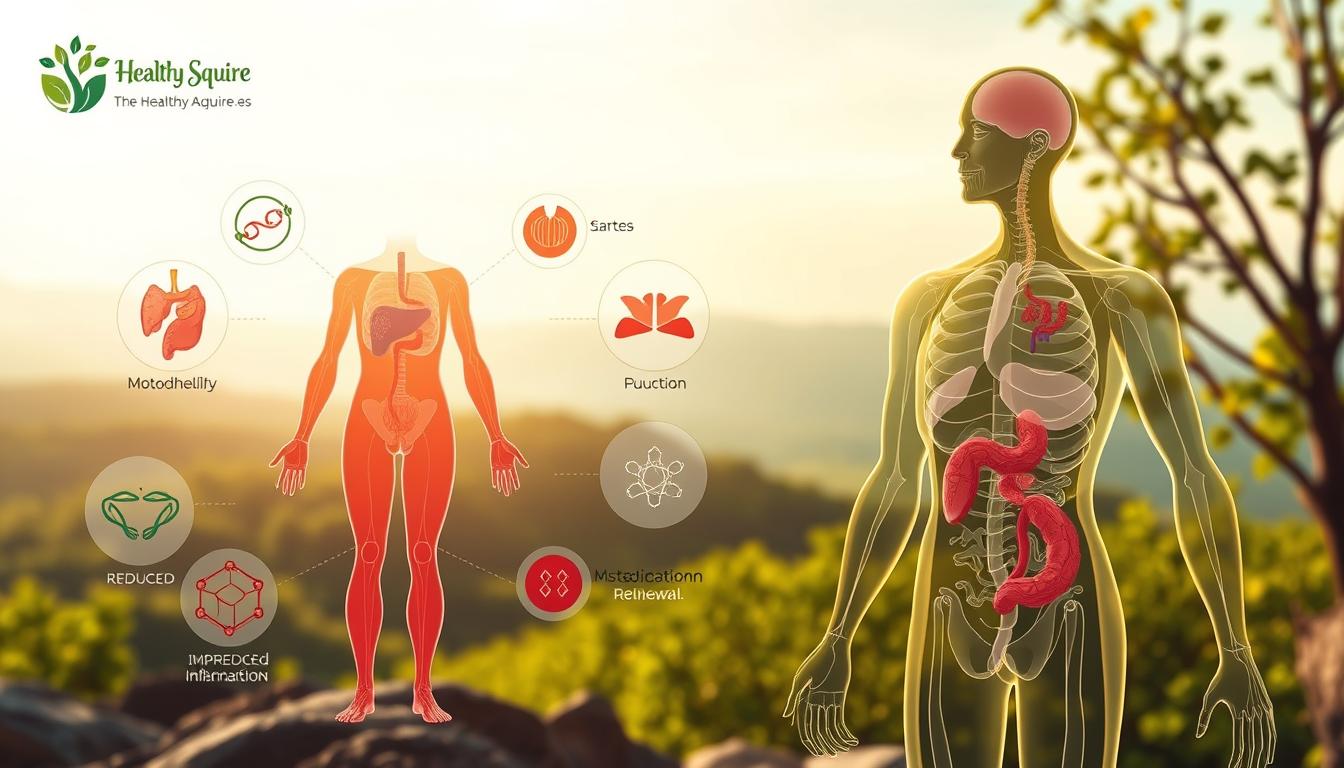
Cancer Risk Research
Autophagy and Tumor Suppression
During long fasts, your cells start a self-cleaning process called autophagy. This process breaks down damaged parts, which might stop cancer-causing mutations. Studies on rodents show fasting can kill off cancer cells while keeping healthy cells safe.
Human studies have shown mixed but interesting results. One study found 72-hour fasting cycles reduced chemotherapy side effects and protected normal cells. But experts warn that animal studies don’t always translate to humans. An oncologist says:
“While autophagy shows tumor-suppressing potential, we need more human data before recommending fasting as cancer prevention.”
Several factors can affect the outcomes:
- Fasting duration and frequency
- Individual metabolic health
- Genetic predisposition to cancer
Longevity Connections
Telomere Length Studies
Telomeres, the protective caps on DNA, get shorter with age. Fasting might slow this down. Studies show that calorie restriction can activate telomerase, an enzyme that keeps these genetic safeguards strong. In one study, people who fasted had telomeres like those 5-7 years younger than non-fasters.
But Blue Zones research shows that longevity comes from more than just fasting. These communities live long lives due to:
- Plant-rich diets
- Regular physical activity
- Strong social connections
Fasting alone doesn’t replicate these results. But when combined with other healthy habits, it could enhance anti-aging effects. Current evidence suggests temporary telomere stabilization, not a reversal of aging. More research is needed to understand this.
Contraindications and Warnings
When looking into the benefits of 36-hour fast, it’s important to know when it might be harmful. This is especially true for people with diabetes and those at risk for eating disorders.
Diabetes Management Concerns
Hypoglycemia Risks
Fasting changes how your body handles sugar. For those with Type 1 diabetes, not eating without adjusting insulin can cause low blood sugar. This is dangerous and can lead to symptoms like shaking and confusion.
People with Type 2 diabetes also need to be careful. While fasting might help with insulin sensitivity, it can also upset their medication. A 2023 study says:
“Fasting needs to be tailored and watched by doctors to avoid big changes in blood sugar.”
| Factor | Type 1 Diabetes | Type 2 Diabetes |
|---|---|---|
| Hypoglycemia Risk | Extremely High | Moderate |
| Medical Supervision Needed | Mandatory | Strongly Recommended |
| Medication Adjustments | Insulin doses often reduced by 30-50% | Metformin may require timing changes |
Eating Disorder Triggers
Psychological Screening
For those with a history of eating disorders, fasting can be dangerous. Studies show a 42% rise in unhealthy behaviors during long fasts.
Before fasting, ask yourself:
- Do I use food restriction to “punish” myself?
- Does skipping meals make me feel in control?
- Have I ever been diagnosed with RED-S (Relative Energy Deficiency in Sport)?
If you said yes to any, talk to a mental health expert. The fasting effects on body can make existing mental health issues worse.
Conclusion
When you fast for 36 hours, your body goes through many changes. It starts by using up stored glycogen and then moves to a deeper cleaning process. This process gets your body ready to handle challenges better.
Studies on fasting diets like ProLon show they can be helpful for some people. But, fasting for 36 hours is not for everyone. People with diabetes or eating disorders should talk to a doctor first.
Fasting affects many parts of your body. It can make your body more sensitive to insulin and improve your brain function. It also helps your immune system get stronger.
Think of 36-hour fasting as one part of a bigger plan for health. Keep an eye on how your body reacts and adjust as needed. Eating well and managing stress are also key. Always check with a doctor to make sure fasting is right for you.